21Views 0Comments

Ultimate Day Trip to Kawagoe: Explore “Little Edo”
Have you ever wondered what it would feel like to stroll around Edo-period Japan? The city of Kawagoe, affectionately known as “Little Edo”, has perfectly preserved its Edo-period ambience and makes for a great day trip from Tokyo.
The main sights of Kawagoe align themselves into a handy loop. While you can see them all in a day, prioritize what takes your fancy so you aren’t rushing around.
Pro tip: Get into the traditional spirit by renting a kimono for the day. Our top pick is Kimono Rental Wargo.
Note: Our itinerary has a counter-clockwise approach for a quieter, temple-led start.
With options ranging from 30 minutes to a over an hour, getting from Tokyo to Kawagoe depends on which station combination you pick. Kawagoe has three train stations to choose from: Kawagoe, Kawagoe-shi and Hon-Kawagoe. All three are pretty central, but Kawagoe Station is about 10 minutes further out compared to Hon-Kawagoe.
Visiting Kawagoe from Shinjuku or Ikebukuro is the most practical option, especially since Seibu Railways has a discount pass for foreign passport holders at ¥700. This nifty pass, which comes in the form of an amulet, covers round-trip travel between Seibu Shinjuku Station, Takadanobaba or Ikebukuro Station, and Hon-Kawagoe Station, and includes discounts at some shops in Kawagoe.
It takes around 45 minutes on the Koedo limited-express train (separate seating fee of ¥600 one way), or an hour to an hour and 15 minutes on regular trains.
Pro tip: Add an extra dimension to your Kawagoe visit with a private tour.
Temple run: Heading east to Kita-in Temple and its neighbors
A 20-minute walk from Kawagoe Station, or 10 minutes from Hon-Kawagoe Station, Kita-in Temple is the most famous temple in all of Kawagoe. That said, there are a few impressive stops along the way.
Stop off at Kawagoe Hachimangu Shrine
If you take the longer route, you can drop into Kawagoe Hachimangu Shrine and visit the Sacred Gingko Tree there. Minamoto Yorinobu established the shrine just shy of 1,000 years ago. These days, it is famous for being a much-desired wedding location. The towering tree looks particularly incredible in autumn.
Pop into Nakain: Buddhist temple and gardens
Nakain is a couple of streets away from Kita-in, and is one of a three-temple complex with beautiful gardens. It has a history as the birthplace of Sayama Tea after the priest Jikaku planted seeds in the grounds, with a stone monument marking this.
The gardens of Nakain feature weeping cherry trees and rare kanhizakura (Taiwan cherry trees), attracting many visitors. Usually in mid-March, during peak blossom season, you can witness the breathtaking sight of their evening illuminations.
Get a Ubigi eSIM for Japan (in advance!)
Access to affordable, high-speed mobile data while in Japan is a must. Ubigi has popular packages in the 10GB–25GB range, as well as unlimited data plans for power users. TIP: Use code TOKYOCHEAPO for 10% off.
Kita-in Temple: HQ of Tendai Buddhists

Kita-in’s grounds house several Important Cultural Properties. Notable examples include the 540 Rakan (Buddha’s disciples) statues, and Semba Tōshōgū Shrine, which honors Ieyasu Tokugawa. In the gardens on the temple grounds, you can see many seasonal blooms including cherry blossoms, hydrangeas, and azaleas.
Each year in January, the temple holds a Daruma Market, where you can buy daruma dolls to bring you luck for the year.
Heading north to Kawagoe Castle Honmaru Palace
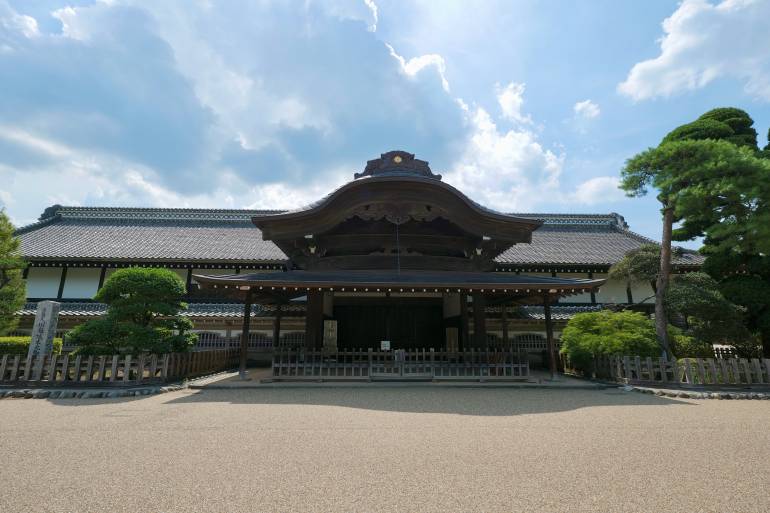
Interested in Kawagoe’s ancient history? In that case, make sure to visit Honmaru Goten. The only remnant of Kawagoe Castle, its name translates roughly to the palace of the inner-most circle of defense. Dolls recreate scenes of feudal lords discussing important matters, which once happened in the hall.
Although the castle itself was originally built in 1457, the current building is only from 1848. Nearby there are some grassy moats and turret remains, but there’s not a whole castle to see.
Going west for Edo-era streets and alleys
Many people visit Kawagoe because its a visual symbol of Japan’s past. While the Ko-edo nickname gives a lot away, the city also reflects other eras of Japan.
Escape the heat in Tokyo! (7 FREE indoor spaces + getaway ideas)
Looking for refreshing places to rest, besides your hotel? Explore these cool oases around Tokyo and Shibuya. Plus – lush, green areas like Kusatsu and Kamikochi are easily accessible by bus. …
Kurazukuri Street: Edo at its best
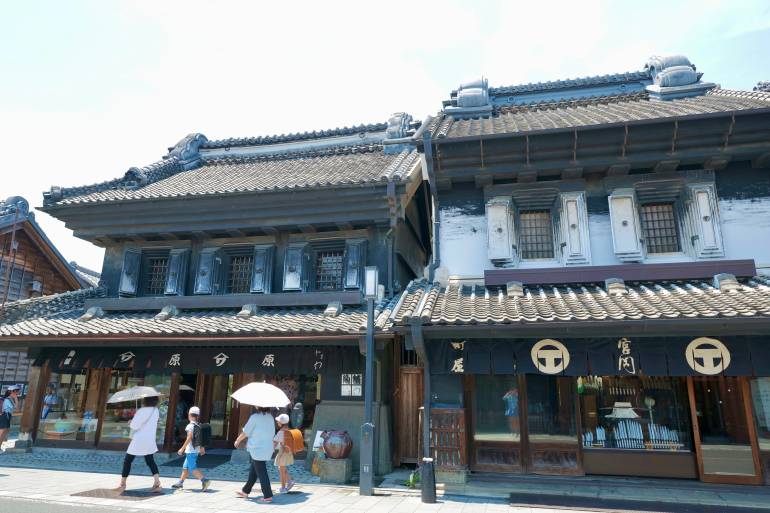
For those unfamiliar with the word kurazukuri, it refers to a type of architecture for warehouses. It is characterized by steep tiles and fire-resistant clay walls, which merchants sorely needed after a great fire destroyed the area in 1893.
Kurazukuri Street, together with nearby side streets, has more than 200 kurazukuri houses. These days, most of them have been converted into shops and restaurants.
Many of the shops on this street sell traditional crafts and handicrafts, which make for nice souvenirs. Some offer pottery and glass-blowing workshops.
Not only are there tons of traditional goods, but also a lot of character goods. Along the main road, you’ll find a Miffy Kitchen & Bakery, Donguri Kyowakoku (a Studio Ghibli Shop), and Snoopy Village Kawagoe.
Kurazukuri’s museums: Daily life, festivals and art
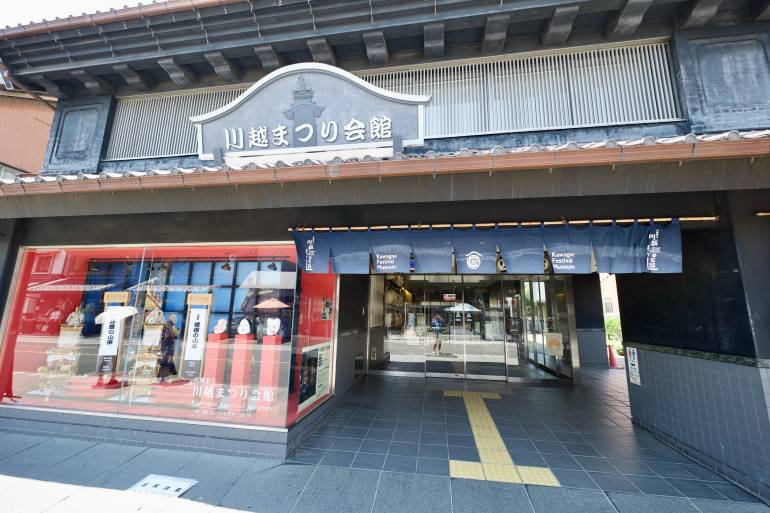
Notably, the oldest kurazukuri in town is Osawa House. Built in 1792, it is registered as an Important Cultural Property. There’s also the small Yamazaki Art Museum, which is inside a kurazukuri house.
Another highlight is the Kawagoe Matsuri Kaikan, a museum dedicated to the city’s impressive annual festival. If you’re not lucky enough to witness it in person, this small museum offers a chance to see the towering floats and feel the atmosphere of the famous October event.
Pro tip: Before leaving, stop by the Nakamachi Information Center to get free Kawagoe-themed stamps (for you stamp collectors out there).
Toki no Kane: The landmark bell tower of Kawagoe
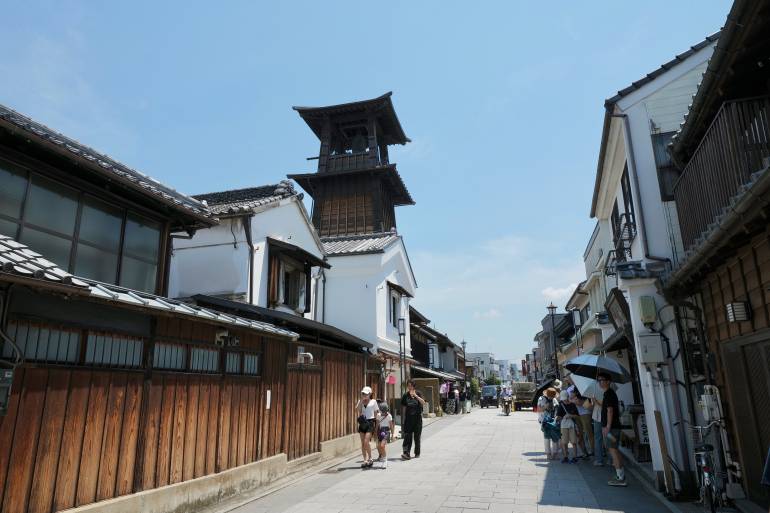
By far the most famous symbol in all of Kawagoe is a bell tower called Toki no Kane, which translates to “Bell of Time”.
Standing 16 meters high, this tower told time back in the day. Even today, it rings four times daily at 6 a.m., 12 p.m., 3 p.m., and 6 p.m. It’s coincidental that the tower has undergone four reconstructions — the last one following the great fire of 1893.
Note: You’ll see a very similar bell at Senkyaku Banrai, next to Toyosu Fish Market in Tokyo.
Kashiya-Yokocho: Hitting the sweet spot
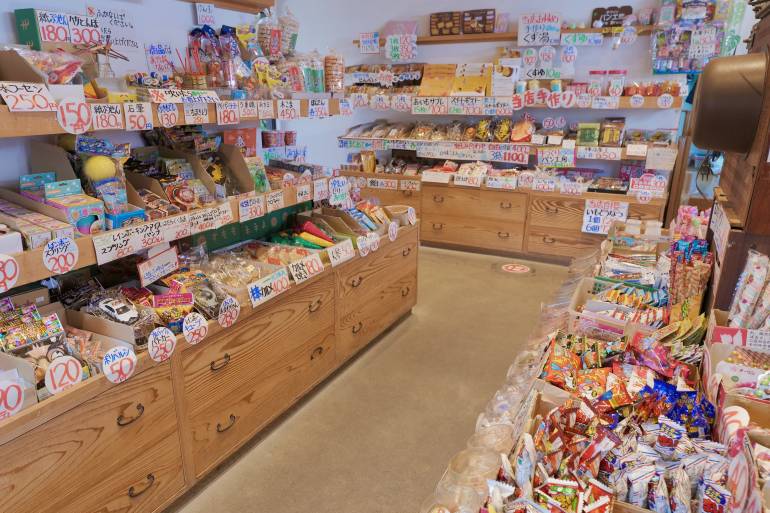
To the west of Kurazukuri Street is Kashiya Yokocho. It’s famously known as “Sweets Alley”. Here, you can find low-priced sweets and snacks. Many of them are reminiscent of those popular during the post-war Showa era.
As well as traditionally crafted sweets, you can enjoy some sweet-potato treats. Kawagoe is known for sweet potatoes, which are a much-loved treat — especially in the colder months.
Where to start? Well, let’s see: Zaumon sells a tasty kurazukuri-shaped manju, while Yoshiokaya is the place to go for old-fashioned sweets. There’s also the local speciality of Fugashi bread to try.
Fans of Chiikawa, one of Japan’s most popular cartoon characters, rejoice, as you can visit Chiikawa Mogumogu Hompo — a store dedicated to these cute creatures.
Note: Want to know more about Edo history? Check out A Day in Edo Tokyo: Top 5 Edo Period Sightseeing Spots in the Capital.
South to Taisho Roman-dori and Renkeiji Temple
Heading south and back towards the train stations, you’ll come across Taisho Roman Yume Street and a final stunning temple.
Taisho Roman-dori: Returning to modernity
Interestingly, the Roman in this street’s name is actually short for “romantic,” and “yume” means “dream.” Just like the rest of the streets, this one is a blast from the past, albeit from a different era — the Taisho Era (1912-1926).

Down the street, there are several local shops, including a stationery store and textile store. You’ll also find a variety of old-school coffee shops and restaurants. For an authentic kissaten experience, head to Shimano Coffee Taishō-kan, where you can sip on a classic melon soda and enjoy some caramel pudding.
All the shops on Taisho Roman-dori are housed in Western-style buildings. It offers the perfect way to walk yourself back from Edo times to the present day.
Renkeiji Temple: Cherry blossom and statues galore
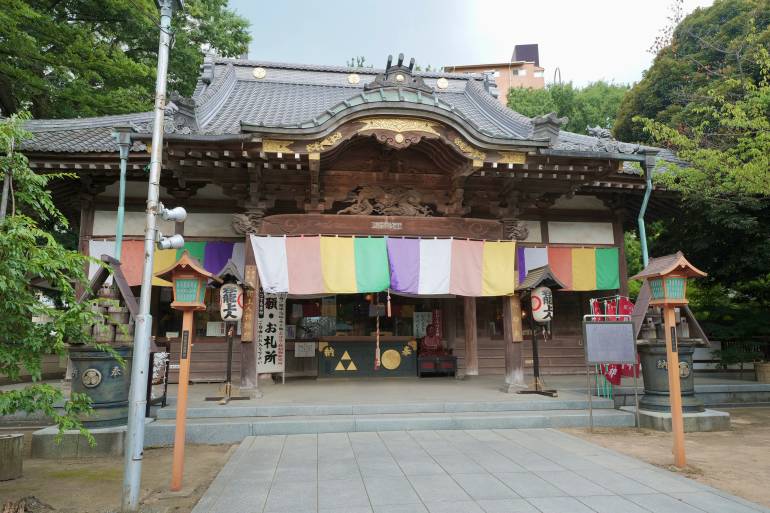
Founded in 1549 to provide a sanctaury for common people, Renkeiji is fittingly one of the quieter temples in the area. Unless you visit in spring, however, when cherry trees bring swathes of pink to the complex grounds.
The temple is home to one of Kawagoe’s Seven Lucky Gods, enshrining Fukurokuju, god of fortune, longevity and happiness. There’s also a statue that heals illness and injury, so you’ve got all bases covered.
Other things to see in Kawagoe
Hikawa Shrine
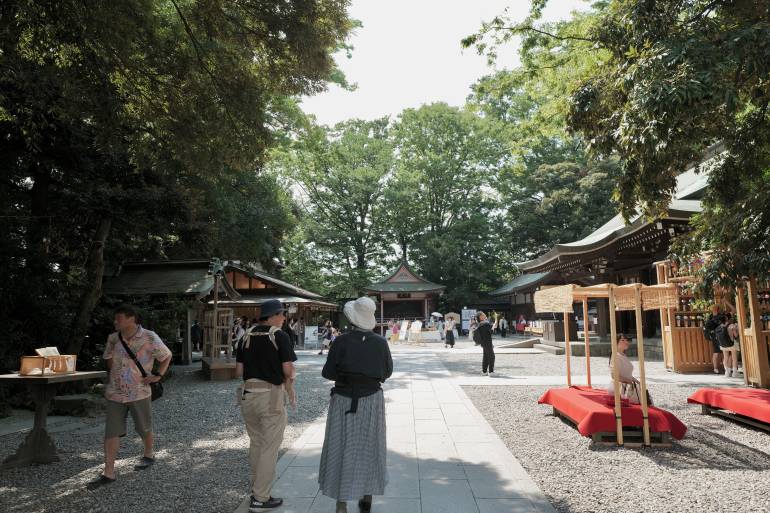
Hikawa Shrine is Kawagoe’s most popular shrine, enshrining the god of marriages and featuring a 15-meter torii (Shinto shrine gate). But the best part of this shrine is definintely the entrance, which is covered in colorful Japanese wind chimes.
Note that the wind charms are only displayed from June to September each year (find out more about the event). With its relaxing atmsophere and sweet potato-themed omikuji (fortune slips), it feels quintessentially “Kawagoe” and offers the perfect place to sit and ponder.
Kumano Shrine
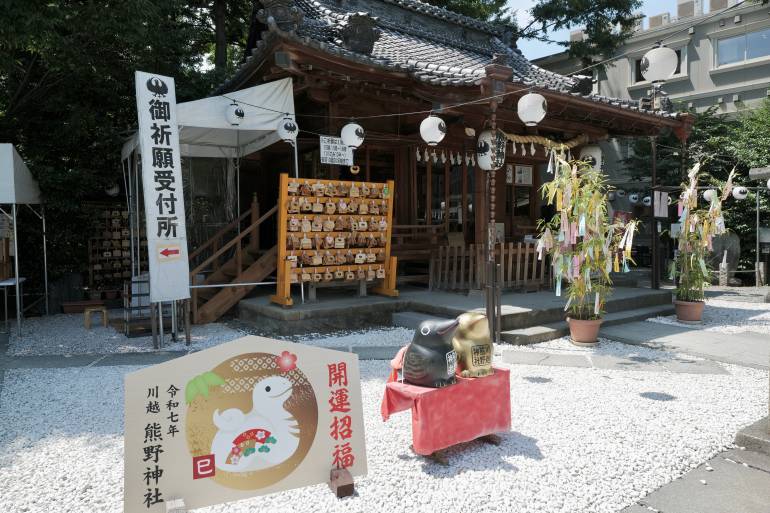
Following your visit to Renkeiji, you can walk about 18 minutes to reach Kumano Shrine. Known for bringing good fortune and love to those who visit, this shrine has several notable features that make it worth a stop.
One rare aspect is the pebble walkways leading up to the shrine. You should walk on these barefoot, as they are said to stimulate acupuncture points and are believed to offer health benefits.
One of the shrine’s other highlights is its main motif — Yatagarasu (the three-legged crow). You’ll find this symbol on the shrine’s good luck charms as well as in statues around the grounds. Despite being a relatively small shrine, it definitely has a distinct atmosphere.
What to eat in Kawagoe
In Kawagoe, you’ll find a variety of traditional-style places to eat. Whether you’re in the mood for street food or dining at a ryotei — a classy traditional restaurant — there’s something for everyone and every budget.
Surprisingly, some of the Kawagoe ryotei offer relatively inexpensive lunch sets. For high-quality food, anything under ¥2,000 is quite reasonable. You can check out a list of ryotei in Kawagoe here.
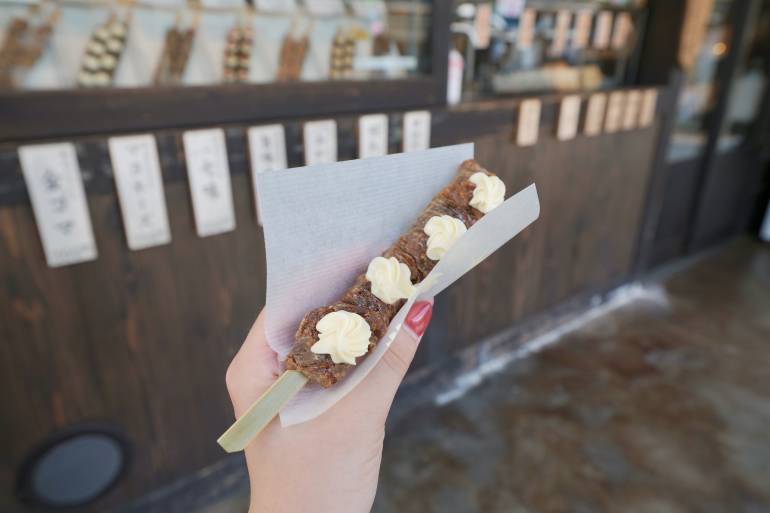
Fancy a light bite and enjoy trying different types of food? Luckily, many places along Kurazukuri Street sell street snacks. These include mitarashi dango, pickled cucumber on a stick, and more.
We recommend heading to Okakidokoro Terakoya Honpo to try their unique fried senbei. Starting from ¥200), this senbei on a stick is often mistaken for grilled chicken yakitori, since they look so alike.
There’s also Ebisu-an, a noodle shop that also sells dashi maki tamago (Japanese-style omelette on a stick). With so many interesting flavors to try, we opted for the seaweed mentaiko cream cheese — definitely worth stopping by for.
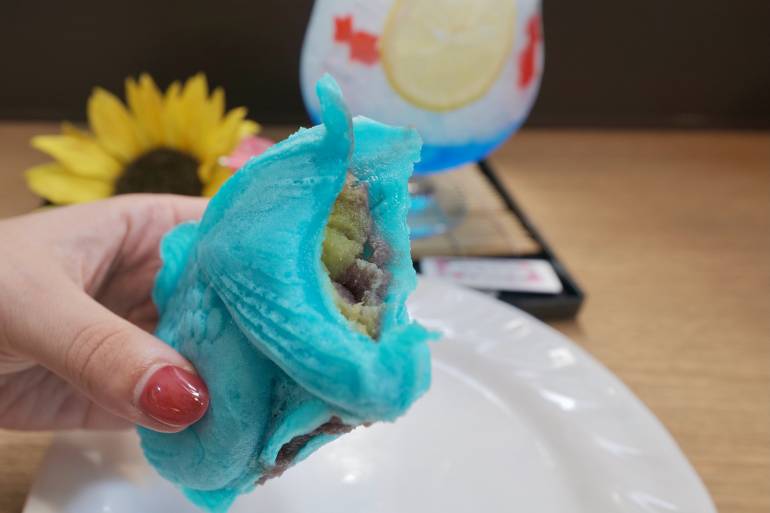
Go to Café & Bar Kingyotei if you want to relax at a cute café and enjoy something sweet. This goldfish-themed spot serves refreshing summer sodas and colorful taiyaki stuffed with Kawagoe’s specialty — that good old sweet potato.
Matcha
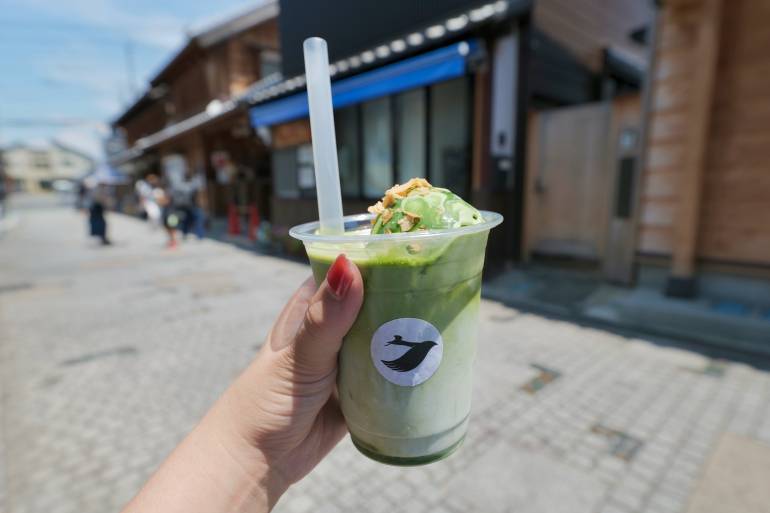
Any traditional Japanese town should have matcha, and Kawagoe is no exception. There are many old-school and more contemporary matcha cafés to choose from, with Matcha Arata being our top pick. Not only can you order a variety of iced matchas and sodas, but also kakigori (shaved ice) and crepes if you’re craving something sweet.
We suggest getting the Premium Matcha Ice Latte. Although it’s on the pricier side at ¥1,000, it’s like a drink and dessert in one.
Bonus activity: The Kawagoe Seven Lucky Gods Pilgrimage
If you like temples, the Lucky Gods pilgrimage is a lovely way to spend a couple of hours in Kawagoe. The route is 6km long, so it will leave you with a great step count. Not only that, but taking this pilgrimage is meant to give you all the wealth, longevity and courage you could need.
Start from any of the main stations and you’ll stay well within walking distance of all the main sights. Your journey will take you to each of the Seven Lucky Gods, visting their associated temples one by one.
Temples to visit for the Kawagoe Seven Lucky Gods Pilgrimage (Shichifukujin)
- Myōzenji Temple: Bishamonten — the god of courage and wealth.
- Tennenji: Jurojin — the deity of longevity.
- Kitain Temple: Daikokuten — god of food and wealth.
- Naritasan Temple: Ebisuten — brings fortune and prosperity (a long-time favorite with fisherman and farmers).
- Renkeiji Temple: Fukurokujin — bestows happiness and protection from diaster.
- Kenryuji: Hoteison — the big-bellied god who grants family harmony, household propserity, and fertility.
- Myoshoji: Benzaiten — granter of happiness and good fortune.
Note: There is no particular order; you just need to visit all seven temples.
Is a day trip to Kawagoe worth it?
There’s a reason so many people visit Kawagoe. It’s easily accessible from Tokyo and offers a great glimpse into Japan’s history, from the Edo to Showa periods. With numerous points of interest — such as shrines, temples, shops, and tasty local food, you can honestly experience Japanese culture at its best here.
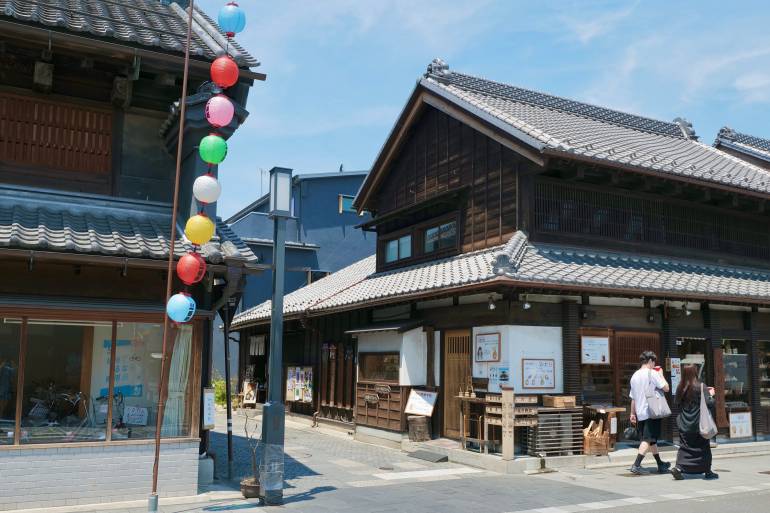
Unlike some other Tokyo day trips, Kawagoe is one you can do in any season — though it does look prettiest during spring and fall. It’s an ideal choice for those seeking a slower-paced day full of rich history and delicious local food.
Kawagoe FAQs
How much time do you need in Kawagoe?
Since there’s quite a bit to see and do in Kawagoe, we suggest spending the whole day there. You don’t need to worry too much about transport, as trains from Kawagoe to Tokyo run frequently. Just note that the area does become a bit sleepy around 5 to 6 p.m.
Is Kawagoe crowded?
It is true that Kawagoe can get quite crowded, especially around Kurazukuri Street. Thanks to the area’s traditional, Kyoto-esque charm, the streets get busy on weekend afternoons. If possible, we recommend visiting on a weekday. Keep in mind that shop and museum opening days vary, so it’s best to check ahead.
While we do our best to ensure it’s correct, information is subject to change. Article first published in 2015, by Tiffany. Last updated in August 2025, by Jane Pipkin.



